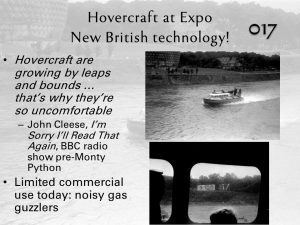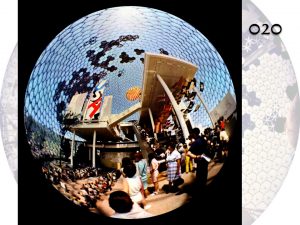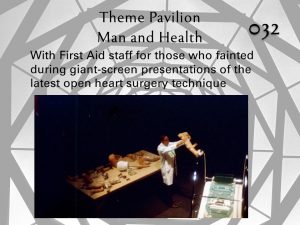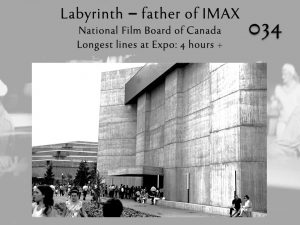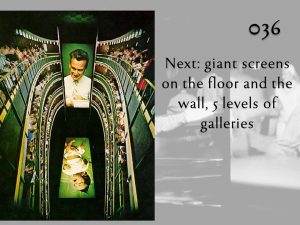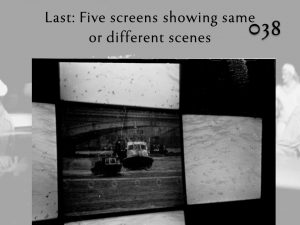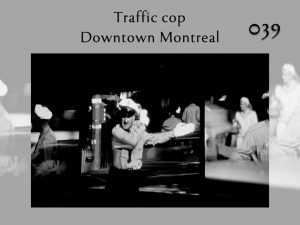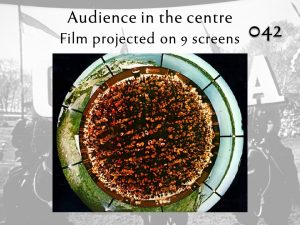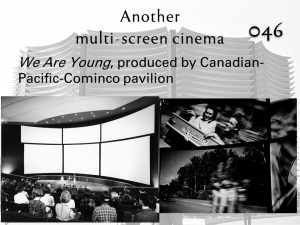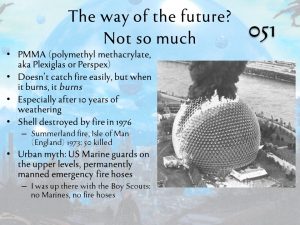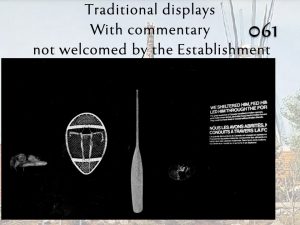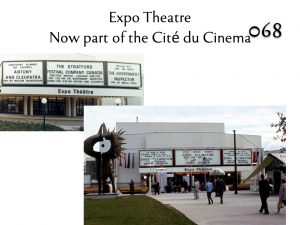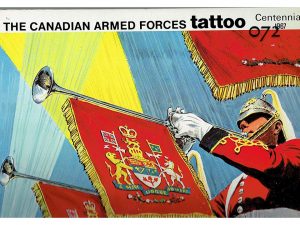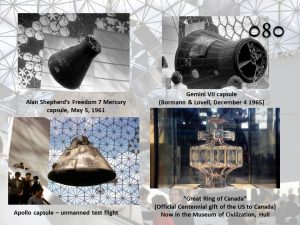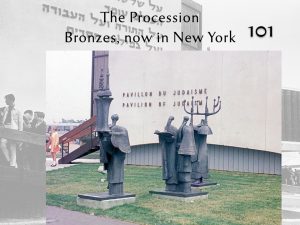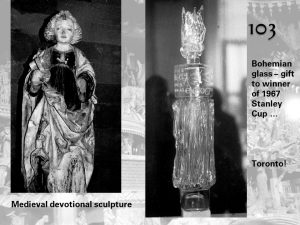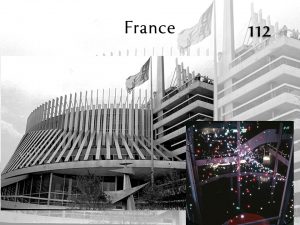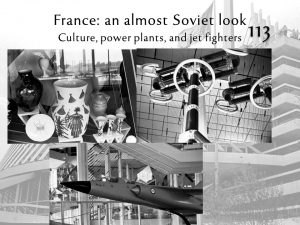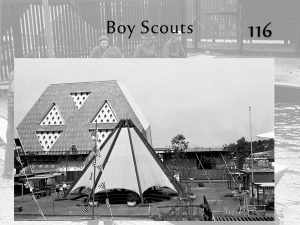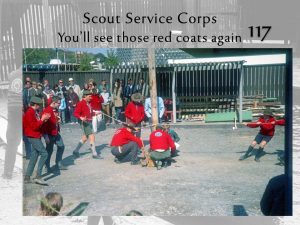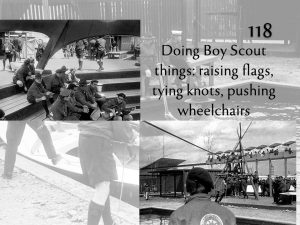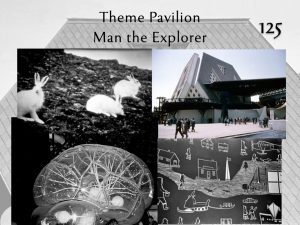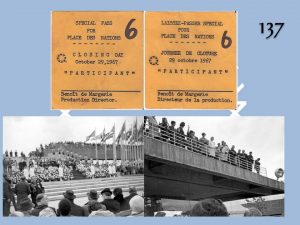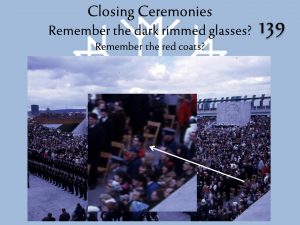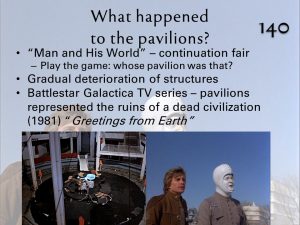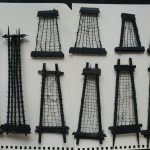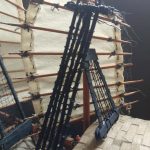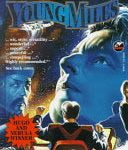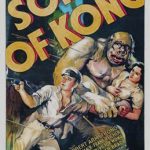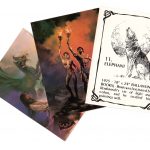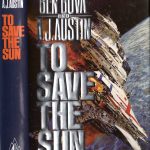
This is Post 7 of 8.
10) SHOW-AND-TELL
For those participating on ZOOM, today, we open the floor to any club members who have “fancraft” projects to showcase—sci-fi scale models, SF/F woodworking or needle crafts, whatever genre-themed, hands-on project it may be that you are currently working on, or have recently completed.
Those not able to join our ZOOM chat for this show-and tell may, at this time, review the following:
11) ANSWERS TO QUICKIE QUIZ
Here are the answers to the Quickie Quiz we posted at the outset of today’s meeting (see Post 1 of 8). How many titles did you remember correctly?
1) What was the title of that old science fiction anthology series produced back in the 1950s, I think it was? You know, the one that began each episode with the host demonstrating a simple science experiment which was related to that week’s episode!
Science Fiction Theatre (1955-1957) was an anthology series produced by science fiction movie director/screenwriter Ivan Tors and hosted by radio/television announcer and 1940s film actor Truman Bradley.
The show put an emphasis on the “science” in “science fiction,” offering “what if” extrapolations rooted in known scientific fact. Stories involved space flight, time-travel, robots, flying saucers and extraterrestrials, mental telepathy, and more. Each episode opened in a laboratory replete with a variety of scientific instruments where Bradley conducted a quick science experiment for the audience, one which related to the fictional story about to be presented.
The series came out of the ZIV company, an American producer of episodic television programs for first-run syndication in the 1950s. Science Fiction Theatre was a forerunner of later, better known shows like The Twilight Zone and The Outer Limits, and was retitled Beyond the Limits for another syndicated run in the 1960s, airing, as well, on PBS and the Sci-Fi Channel in later decades.
2) What was the title of that classic Star Trek episode, the one where Captain Kirk delivers a stirring speech about risk?
“Return to Tomorrow” (1968), a second-season episode penned by John T. Dugan, writing as John Kingsbridge. Diana Muldaur guest-starred as crewmember Dr. Ann Mulhall; the actress would appear again as Dr. Miranda Jones in the show’s third-season episode “Is There in Truth No Beauty?” As well, she joined the season-two cast of Star Trek: The Next Generation (1987-1994), playing chief medical officer Dr. Katherine “Kate” Pulaski, departing after the season concluded. Muldaur, it seems, has a penchant for playing doctors on Star Trek!
The Enterprise responds to a distress call and on an otherwise lifeless planet finds the incorporeal minds of “fantastically advanced” aliens Sargon, Henoch, and Thalassa housed within disco balls in a subterranean chamber. Leader Sargon requests of Kirk that the three beings be permitted to temporarily inhabit the bodies of the captain, Spock, and Dr. Mulhall so that they may construct android bodies for themselves, after which the borrowed bodies of the Enterprise personnel would be returned. Kirk feels that he can trust Sargon and despite the “enormous danger potential” involved, champions the idea, delivering in support of the proposal one of Star Trek’s finest inspirational orations—“Risk. Risk is our business. That’s what this starship is all about. That’s why we’re aboard her.”
But Henoch has an idea of his own!
James “Scotty” Doohan provided the voice of Sargon.
3) What was the title of that 1960s science fiction/horror movie featuring an exotic, green-skinned alien woman who turns out to be a vampire?
Queen of Blood (1966), also known as Planet of Blood, was said by the film’s writer/director, Curtis Harrington, to have inspired, to some degree, Ridley Scott’s Alien (1979). “Ridley’s film is like a greatly enhanced, expensive and elaborate version of Queen of Blood,” he professed in an interview.
In the far-flung future of 1990, an alien race has contacted mankind and are sending an ambassador to Earth.
When a strange, green-skinned woman whose spaceship has apparently crashed on Mars is found unconscious, she is taken aboard a rescue ship dispatched from Earth. Regaining consciousness, she smiles tantalizingly at the Earthship’s three male crewmembers, but frowns at the only female astronaut aboard.
The strange woman soon entrances, attacks, and kills one of the men, then later another, draining them of their blood. Finally, the female crewmember interrupts her attempt to kill and feed upon the third crewman, grappling with the vampiric alien, who succumbs screaming to a mere scratch inflicted upon her during their struggle.
It is deduced that she was a hemophiliac. Further, her eggs are found hidden about the ship, leading to the conclusion that she was the bee-like queen of her people and had been sent to Earth not as an ambassador, but to secure fresh feeding grounds and breed.
Czech-born French film actress Florence Marly played the Queen of Blood, and the eclectic cast included John Saxon, Dennis Hopper, Judi Meredith, Basil Rathbone, and Forrest J Ackerman. Special effects footage was lifted from the Soviet SF films Mechte Navstrechu and Nebo Zovyot, respectively in English, A Dream Come True and Battle Beyond the Sun. The story was derived from Mechte Navstrechu’s screenplay. Roger Corman, though uncredited, was behind the project.
4) And then there was another science fiction/horror picture I remember seeing many years ago, with Hammer stars Christopher Lee and Peter Cushing. You know, the one where a frozen, primeval monster discovered in a cave is being transported to Europe on the Trans-Siberian Express. The creature awakens and begins picking off passengers one by one! What was the name of that one, again?
Horror Express (1972), a Spanish/UK co-production featuring Lee and Cushing, in addition to Telly “Kojak” Savalas as a Cossack officer. Eugenio Martin conceived of the story and directed.
As was common practise at the time, Spanish- and Italian-made films were shot silent, with the cast’s voices and sound effects added in post-production. The English-speaking players provided their own voices, here, while other performers dubbed those of Argentinian actor Alberto de Mendoza and Spanish actress Silvia Tortosa.
Lee plays a renowned English anthropologist who is transporting to Europe by rail the frozen remains of a primitive humanoid creature he has discovered. He hopes his find will prove to be a missing link in the story of human evolution. But the creature thaws and escapes its crate, and the bodies soon begin to pile up aboard the train. Cushing is Lee’s friendly rival and the two soon determine that the humanoid creature had been taken over by an ancient, amorphous extraterrestrial entity that robs its victims of their memories and knowledge. When a police inspector shoots the creature, the alien entity jumps hosts, now inhabiting the inspector. And so begins the real threat to everyone aboard the train!
Horror Express is at the heart of a 2021 episode of Shudder’s revived Creepshow series, wherein an inventor creates a VR system that allows him to immerse himself within any movie he wishes. Horror Express happens to be his favourite film, and he visits the setting often, interacting with the Lee and Cushing characters, and romancing Silvia Tortosa’s beautiful Countess Irina, much to the chagrin of his actual wife!
5) What was the title of that Saturday-morning sci-fi show about young cadets attending a space school built on an asteroid? The old guy from Lost in Space was their commander!
Space Academy (1977) was a short-lived live-action children’s television program produced by Filmation, a studio better known for decades of Saturday-morning cartoon series like Star Trek: The Animated Series (1973-1974) and He-Man and the Masters of the Universe (1983-1985).
Lost in Space star Jonathan “Dr. Zachary Smith” Harris headlined the cast as Commander Gampu, head of Space Academy, a school built on an asteroid in the “star year” 3732. Here, young students from across the known worlds were trained to face the challenges of darkest space.
The show’s featured spacecraft were dubbed “Seekers,” and a catchphrase unique to the series was “ORACO,” shorthand for “Orders Received and Carried Out.”
Special effects, meanwhile, were quite serviceable for Saturday-morning fare and viewers were taught a moral lesson with each half-hour episode, of which there were a total of 15.
6) What was the name of that Thunderbirds episode where an attempt to jack up and move the Empire State Building goes catastrophically wrong, requiring the involvement of International Rescue?
“Terror in New York City” (1965), in which the incredible engineering feat of relocating the Empire State Building is underway so as to make way for the rejuvenation of Midtown Manhattan. When a subsidence causes the massive structure and its supporting scaffold to collapse, a television news reporter and his cameraman covering the event become trapped under the fallen building, the men having been thrown down a crevice as the building came down. They find themselves trapped in a cavern filling with water pouring in from the underground river that likely caused the subsidence. The submersible Thunderbird 4 will be required to effect a rescue. But transport Thunderbird 2 is out of commission and thus unable to airlift the little yellow submarine to the disaster site, and time is running out!
Series creator Gerry Anderson was prompted to suggest the story by a newspaper article he’d read about such an operation in Japan. Rather than tearing down an operative department store, the building was carefully moved to make way for a highway redevelopment.
The episode was praised by critics for its larger-than-life scenario and spectacular visuals.
7) What was the title of that old science fiction film about an advanced supercomputer that evolves at an exponential rate and soon exercises complete control over the entire world as a nuclear-armed, God-like guarantor of global peace?
Colossus: The Forbin Project (1970), based on the 1966 D. F. Jones novel Colossus, and the first feature film directed by Joseph Sargent, who had previously helmed television episodes for such genre series as The Invaders, The Man from U.N.C.L.E. and Star Trek.
The story involves the so-named “Colossus,” a forefather to cinematic supercomputers like WOPR and Skynet, featured in, respectively, WarGames (1983) and The Terminator (1984). Colossus is a secret defence project AI designed by a Dr. Charles A. Forbin. Once activated, Colossus quickly transcends its original design imperative as a U.S. and Allied automated nuclear defense system to join with its Soviet counterpart and impose a draconian global peace despite the reluctance of its human creators to cede to it such absolute power. But its control of the American and Soviet nuclear arsenals, and demonstrated willingness to exact cold, pitiless punishment on any who attempt to interfere with its function, leaves mankind with little choice.
Colossus addresses the peoples of the world: “This is the voice of World Control,” it intones in a synthesized timbre. “I bring you peace. It may be the peace of plenty and content, or the peace of unburied death. The choice is yours. Obey me and live, or disobey and die.”
Forbin is now under constant surveillance, held prisoner by the machine he created, and as the film concludes, Colossus explains to him that freedom is an illusion, and that in time, “you will come to regard me not only with respect and awe, but with love.” Forbin’s reply is the film’s closing line: “Never.”
This is a smart science fiction film that holds up well, hobbled today not by obsolete ideas, but only by an obsolete depiction of advanced computer technology.
8) What was the title of that Night Gallery story? You know, the one where Count Baltar is rescued at sea by the Lusitania, distraught at his cowardly behaviour, that of having dressed as a woman in order to get into a lifeboat and escape certain death when the Titanic went down. Then later, he finds himself once again adrift in a lifeboat, one of the Lusitania’s, as the Andrea Doria maneuvers closer to rescue him!
“Lone Survivor” (1971), a segment of the fifth episode of Night Gallery (1969-1973), Rod Serling’s anthology of dark fantasy and supernatural horror, and the follow-up to his celebrated Twilight Zone series.
The framing device for the show was Serling’s introduction of each segment, of which there were usually two or three per episode, standing before a painting hanging in a dark and bizarre art gallery. Each canvas was a representation of the story about to unfold, capturing “in time and space,” to employ Serling’s words, “a frozen moment of a nightmare.”
Any maritime historian will recognize the three ocean liners featured in this tale as doomed vessels—the Titanic famously struck an iceberg and sank in 1912, the Lusitania was torpedoed by a German U-boat in 1915, and the Andrea Doria collided with another ship and sank off Nantucket in 1956. This is a Flying Dutchman-like story which benefits greatly from a splendid performance by Canadian actor John Colicos as the distraught survivor haunted by his own cowardice and condemned to forever wander the seas as a harbinger of doom for ill-fated ships.
Colicos is also known to sci-fi fans as the first on-screen Klingon, Commander Kor, featured in “Errand of Mercy,” a first-season episode of Star Trek (1966-1969), and as the traitorous Count Baltar in the original Battlestar: Galactica (1978-1979). As well, he guest-starred in an episode of the Canadian-made sci-fi series The Starlost (1973-1974).
9) What was the name of that NBC sci-fi series about sea monsters that aired in the mid-2000s? There was a baby sea monster called “Nim.”
Surface (2005-2006), a science fiction series starring Lake Bell as a California-based oceanographer, one of many people around the world who have recently encountered an often dangerous species of heretofore unknown sea life. Another is a North Carolina teenager who comes across one of the creatures just offshore while wakeboarding with friends, later returning to the area to find numerous eggs floating on the waves. He brings one home and hides it in his parents’ aquarium, until it hatches. The infant sea monster is dubbed Nimrod, or Nim, for short.
A conspiracy plotline concerning the origin of the creatures begins to emerge as the series progresses, and we ultimately learn that they were the genetically engineered creations of a secretive biotechnology company eager to keep it all under wraps now that things have run amok.
Described as a “Speilberg-esque otherworldly drama” featuring “appealing characters and heart-pounding emotion and adventure,” the series boasted top-drawer special effects and developed a small but enthusiastic following. 15 episodes were aired in all, the run interrupted by a hiatus while the network covered the 2006 Winter Olympics, and the show was finally cancelled due to poor ratings, leaving the story unresolved.
10) What was the title of that movie, again? It was released not so long ago; you know, the one about a group of guys on a pub crawl who find themselves in the middle of an android take-over!
The World’s End (2013) is an over-the-top madcap, silly, ribald sci-fi comedy with a lot of heart from Simon Pegg, Edgar Wright, and Nick Frost, who previously brought us Shaun of the Dead (2004).
The story revolves around a group of middle-aged Englishmen, old friends, who have reunited in their hometown to embark upon an epic pub crawl. Their route, the “Golden Mile,” will take them to all 12 of the watering holes in town, the last of these being The World’s End. As teenaged schoolboys, more than 20 years ago, they had attempted but were unable to complete the Golden Mile, and at the determined urging of Pegg’s best-days-behind-him, deadbeat character, set out to do so now.
But there’s something eerily strange about the townsfolk they encounter along the way, and by the time they’ve visited the fourth pub on their route, they are shocked to discover that all of the people in the hamlet have been replaced by android simulants!
Hilarity ensues.
11) What was the title of that mid-1970s made-for-television movie about an android in search of his creator? Two Star Trek actors were in it, and so was B. J. Hunnicutt from M*A*S*H!
The Questor Tapes (1974), scripted by Gene Roddenberry and his Star Trek colleague, Gene L. Coon, this movie was the pilot for a never-produced television series.
Robert Foxworth played Questor, an android whose programming is only partially intact and who, with just a snippet of data to guide him, is driven to seek out his brilliant designer, Dr. Emil Vaslovik, who has mysteriously disappeared. To aid in the search, the robot conscripts Jerry Robinson, one of the specialists on the team that assembled him. Robinson and his fellow experts had followed instructions and used components left by Vaslovik, but so advanced was the technology, here, that they did not fully understand that with which they were working.
As the story progresses, Questor gradually becomes more “human,” and eventually, he and Robinson make their way to Mount Ararat, where they find Vaslovik in a cave hidden within the mountain. We learn that Vaslovik is himself an android, and that Questor is the last of a series of automatons left on Earth by extraterrestrials. Each having a lifespan of several hundred years, the androids’ lineage dates back eons, with every individual tasked with fabricating its replacement before it expired.
Their purpose on Earth is to serve and safeguard mankind: “We protect, but we do not interfere. Man must make his own way. We guide him, but always without his knowledge.” And so, with Robinson as his advisor, Questor’s mission begins.
Star Trek’s Majel Barrett and Walter Koenig appeared in the film, she as Dr. Bradley, one of the Project Questor personnel, he, briefly, as an administrative assistant. Mike Farrell, who played Robinson, would soon join the cast of M*A*S*H as B. J. Hunnicutt.
12) What was the name of that animated series about this boy who can breathe underwater by way of a special kind of chewing gum?
Marine Boy (1967-1969), among the earliest colour animé series to air in North America, this program began in Japan, of course, in 1965 as a three-episode, black-and-white experimental show called Dorufin Ôji, or Dolphin Prince. A full-colour, slightly tweaked and expanded version of the concept called Ganbare! Marin Kiddo, or Hang On! Marine Kid followed in 1966, but was cancelled after 13 episodes.
American distributor Seven Arts Television then entered the picture, picking up the series for the English-language and international markets and negotiating a deal whereby additional episodes, including a colour reworking of the original three Dolphin Prince instalments, would be produced to arrive at a total of 78. The English-language dub of the show was retitled Marine Boy and was, in accordance with the deal agreed upon, syndicated in the U.S. before the series was permitted to air in Japan, where it was called Kaitei Shônen Marin, or Undersea Boy Marine.
Serving with the Ocean Patrol, a policing agency with jurisdiction over the Earth’s seven seas, the titular character is an intelligent, athletic, adolescent boy who has an affinity for sea life and can communicate with a sociable dolphin called Splasher. He is also friends with Neptina, a young Mermaid.
Marine Boy’s father, Dr. Mariner, along with a character named Professor Fumble, have invented a variety of accessories to equip the lad for dangerous duty. These include his red, virtually impenetrable wetsuit, sporting a radio communications system, retractable diving flippers, and hyper-powered propulsion units built into the suit’s boot-heels. A handy weapon is his special boomerang, made of a hardened metal alloy and capable of delivering a powerful electric shock. Finally, Marine Boy is able to breathe underwater for extended periods of time by virtue of an oxygen-supplying chewing gum dubbed “Oxy-gum.”
13) What was the name of that old macabre suspense series on NBC? You know the one; it was hosted by Boris Karloff!
Not to be confused with the similar 1970s British program of the same name, the American anthology series Thriller, also known as Boris Karloff’s Thriller and Boris Karloff Presents (1960-1962), was a gothic horror-flavoured murder mystery/crime drama. Iconic Frankenstein star Karloff hosted the series and also appeared in five of the show’s 67 episodes.
Other featured players included Leslie Nielsen, Robert Vaughn, William Shatner, Susan Oliver, Antoinette Bower, Richard Anderson, Richard Chamberlain, Elizabeth Montgomery, Dick York, Mary Tyler Moore, Cloris Leachman, Russell Johnson, Natalie Schafer, Donna Douglas, Marion Ross, George Kennedy, John Carradine, and Hazel Court. Many of these actors and actresses may be familiar to genre fans for past and subsequent roles in sci-fi film and television.
Alfred Hitchcock’s expanded version of his half-hour show, Alfred Hitchcock Presents, spelled the end of Thriller as The Alfred Hitchcock Hour was introduced in September 1962; apparently, the famous director was opposed to a line-up that would have seen two analogous series airing on the same schedule.
 This is our meeting-closing post.
This is our meeting-closing post.



















































